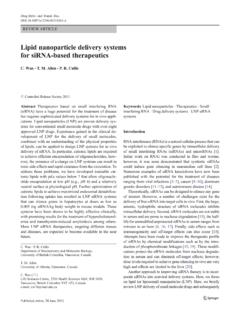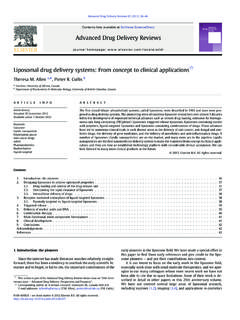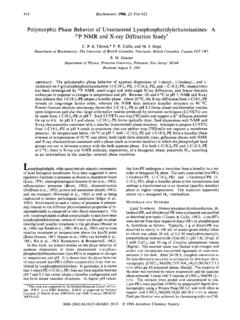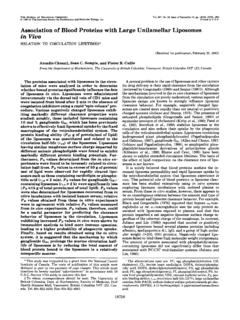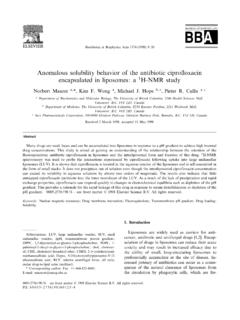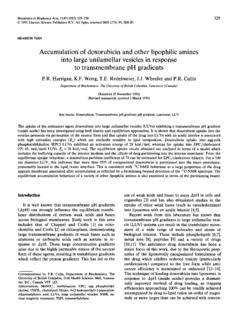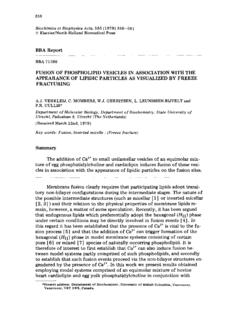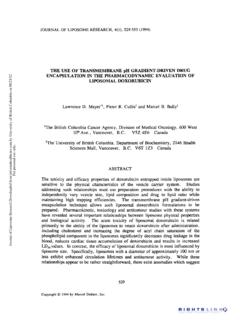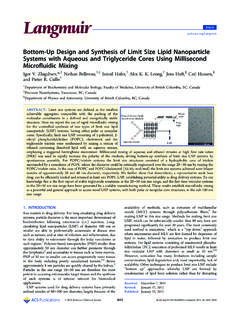Transcription of Influence of Ion Gradients on the Transbilayer ...
1 Biochemistry 1988, 27, 2053-2060 2053 Influence of Ion Gradients on the Transbilayer distribution of dibucaine in Large Unilamellar Vesiclest Lawrence D. Mayer,* Kim F. Wong, Kusum Menon, Carolyn Chong, P. Richard Harrigan, and Pieter R. Cullis Department of Biochemistry, University of British Columbia, 21 46 Health Sciences Mall, Vancouver, British Columbia V6T 1 W5, Canada Received August 4, 1987; Revised Manuscript Received November 18, 1987 ABSTRACT: The uptake of dibucaine into large unilamellar vesicles in response to proton Gradients (ApH; inside acidic) or membrane potentials (A$; inside negative) has been investigated.
2 dibucaine uptake in response to ApH proceeds rapidly in a manner consistent with permeation of the neutral (deprotonated) form of the drug, reaching a Henderson-Hasselbach equilibrium where [ dibucaine ] in/ [ dibucaine ],,, = [H+]i,/[H+],,t and where the absolute amount of drug accumulated is sensitive to the buffering capacity of the interior environment. Under appropriate conditions, high absolute interior concentrations of the drug can be achieved (- 120 mM) in combination with high trapping efficiencies (in excess of 90%). dibucaine uptake in response to A$ proceeds more than an order of magnitude more slowly and cannot be directly attributed to uptake in response to the ApH induced by A$.
3 This induced ApH is too small (I pH units) to account for the transmembrane dibucaine concentration Gradients achieved and does not come to elec- trochemical equilibrium with A$. Results supporting the possibility that the charged (protonated) form of dibucaine can be accumulated in response to A$ were obtained by employing a permanently positively charged dibucaine analogue (N-methyldibucaine). Further, the results suggest that A$-dependent uptake may depend on formation of a precipitate of the drug in the vesicle interior. The uptake of dibucaine into vesicles in response to ion Gradients is of direct utility in drug delivery and controlled release applications and is related to processes of drug sequestration by cells and organelles in vivo.
4 %e ability of ion Gradients resulting in membrane potentials (A$) and pH Gradients ( ApH) to dramatically Influence the transmembrane distributions of certain lipophilic cations and anions is well established. For example, the transmembrane distributions of probes of membrane potential ( , methyl- triphenylphosphonium) or probes of pH Gradients ( , me- thylamine) are used routinely in biological systems to deter- mine A$ and ApH (Waggoner, 1979; Lichtstein et al., 1979; Nicholls, 1979). In recent work employing large unilamellar vesicles (LUVs), we have pointed out that these ion Gradients not only can result in large transmembrane concentration Gradients of lipophilic cations but also can result in high absolute con- centrations in the LUV interior.
5 In the case of the membrane potential probe safranine, for example, A$-driven interior concentrations in excess of 100 mM can be achieved employing initial exterior concentrations of 2 mM (Bally et al., 1985). Similar A$-dependent effects have been observed for chlor- promazine (Bally et al., 1985), dibucaine (Mayer et al., 1985a), and doxorubicin (Mayer et al., 1985b) among others. Two points of interest raised by these observations concern the utility of ion Gradients for loading liposomal systems for drug delivery applications and the mechanisms whereby such redistributions proceed. For example, entrapping drugs in liposomal systems employing common passive trapping pro- cedures usually results in relatively low drug to lipid ratios and trapping efficiencies which rarely exceed 50% (Mayer et al.)
6 , 1986b; Cullis et al., 1987). Uptake in response to membrane potentials can result in significantly improved characteristics. In the case of doxorubicin, for example, A+-driven uptake can This research was supported by the Medical Research Council of Canada. is an MRC Scientist. 0006-2960/88/0427-2053$01 .50/0 result in drug to lipid ratios an order of magnitude higher than available through other procedures, in combination with trapping efficiencies in excess of 95% (Mayer et al., 1986b; Cullis et al., 1987). We have addressed the mechanism of ion gradient driven uptake employing lipophilic cations where the cationic char- acter is provided by an amino function.
7 Such lipophilic amines, which constitute a large proportion of commonly employed drugs (including doxorubicin and dibucaine ), can exist in a neutral (deprotonated) form at higher pH values in addition to the positively charged form. It is commonly thought that the charged form is relatively impermeable, whereas the neutral form can readily permeate membranes (Yeagle et al., 1977). In systems exhibiting transmembrane pH Gradients , this results in equilibrium transmembrane concentration Gradients where [AH+]in/[AHt]o,,t = [H+]i,/[H+]out, where A indicates the lipophilic amine. The question therefore arises as to whether the protonated or the neutral form is accumu- lated by systems exhibiting a A+.
8 In the present work, we employ dibucaine as a model li- pophilic amino-containing compound and characterize the uptake behavior in response to pH Gradients and membrane potentials. In LUV systems exhibiting pH Gradients , rapid uptake levels reaching interior concentrations in excess of 120 mM can be achieved, in combination with trapping efficiencies in excess of 90%. The Transbilayer concentration Gradients obtained and the Influence of interior buffering capacity are I Abbreviations: LUV, large unilamellar vesicle; DIB, dibucaine ; DPPC, dipalmitoylphosphatidylcholine; PC, phosphatidylcholine; MLV, multilamellar vesicle; NMR, nuclear magnetic resonance; Pi, inorganic phosphate; TPP, tetraphenylphosphonium; KGlu, potassium glutamate; TLC, thin-layer chromatography; Hepes, N-(2-hydroxyethyl)- piperazine-N -2-ethanesulfonic acid.
9 0 1988 American Chemical Society 2054 BIOCHEMISTRY MAYER ET AL. shown to be consistent with transport of the neutral form of the amine. Alternatively, uptake in response to A+ proceeds more slowly and cannot be directly accounted for by A+-in- duced pH Gradients . MATERIALS AND METHODS Materials. dibucaine hydrochloride, valinomycin, and all salts were purchased from Sigma Chemicals. Tritiated DPPC, [ 14C] tetraphenylphosphonium, ['4C]inulin, and [ 14C]- methylamine were purchased from New England Nuclear. Egg PC was purified by standard procedures and was greater than 99% pure as detected by thin-layer chromatography (TLC) . Preparation of Large Unilamellar Vesicles.
10 Large unila- mellar vesicles (containing pCi of [3H]DPPC/pmol of phospholipid) were produced by extrusion of frozen and thawed MLVs (Mayer et al., 1985c) 10 times through poly- carbonate filters as previously described (Hope et al., 1985) employing an extrusion device (Lipex Biomembranes, Van- couver). Vesicles prepared in this manner had trapped volumes of pL/pmol of phospholipid employing [14C]inulin as an aqueous marker. Phospholipid concentrations and specific activities were determined by analysis of lipid phosphorus as described previously (Fiske 8t Subbarow, 1925). dibucaine Uptake Experiments. Transmembrane Na+/K+ Gradients were created by preparing LUVs in the presence of a K+-containing buffer and passing the vesicles over a Seph- adex G-50 gel filtration column equilibrated in the appropriate Na+-containing buffer of equal osmolarity.
